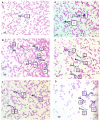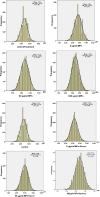Hemotoxic effects of polyethylene microplastics on mice
- PMID: 36969612
- PMCID: PMC10030681
- DOI: 10.3389/fphys.2023.1072797
Hemotoxic effects of polyethylene microplastics on mice
Abstract
Micro- or nanoplastics, which are fragmented or otherwise tiny plastic materials, have long been a source of environmental worry. Microplastics (MPs) have been well documented to alter the physiology and behavior of marine invertebrates. The effects of some of these factors are also seen in larger marine vertebrates, such as fish. More recently, mouse models have been used to investigate the potential impacts of micro- and nanoplastics on host cellular and metabolic damages as well as mammalian gut flora. The impact on erythrocytes, which carry oxygen to all cells, has not yet been determined. Therefore, the current study aims to ascertain the impact of exposure to various MP exposure levels on hematological alterations and biochemical indicators of liver and kidney functions. In this study, a C57BL/6 murine model was concentration-dependently exposed to microplastics (6, 60, and 600 μg/day) for 15 days, followed by 15 days of recovery. The results demonstrated that exposure to 600 μg/day of MPs considerably impacted RBCs' typical structure, resulting in numerous aberrant shapes. Furthermore, concentration-dependent reductions in hematological markers were observed. Additional biochemical testing revealed that MP exposure impacted the liver and renal functioning. Taken together, the current study reveals the severe impacts of MPs on mouse blood parameters, erythrocyte deformation, and consequently, anemic patterns of the blood.
Keywords: PE-MPs; erythrocytes; helmet cells; liver functions; mice.
Copyright © 2023 Abdel-Zaher, Mohamed and Sayed.
Conflict of interest statement
The authors declare that the research was conducted in the absence of any commercial or financial relationships that could be construed as a potential conflict of interest.
Figures




References
-
- al-Sabti K., Metcalfe C. D. (1995). Fish micronuclei for assessing genotoxicity in water. Mutat. Res. 343 (2-3), 121–135. - PubMed
-
- Ammar E., Mohamed M. S., Sayed A. E.-D. H. (2022). Polyethylene microplastics increases the tissue damage caused by 4-nonylphenol in the common carp (Cyprinus carpio) juvenile. Front. Mar. Sci. 9. 10.3389/fmars.2022.1041003 - DOI
LinkOut - more resources
Full Text Sources

